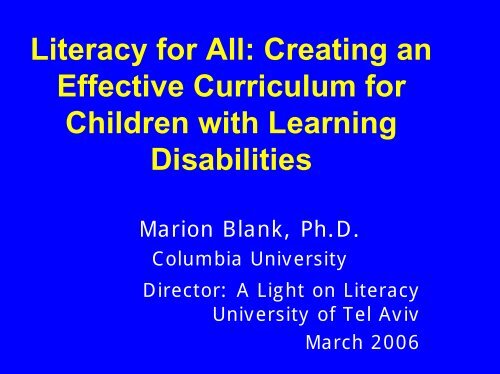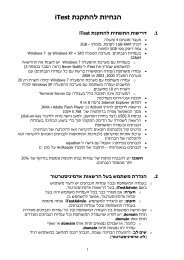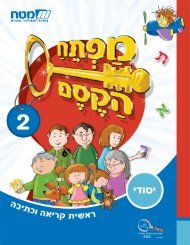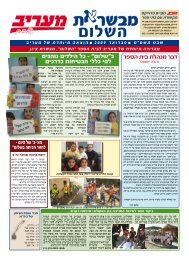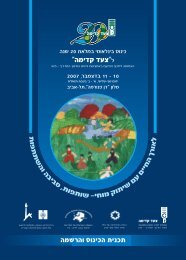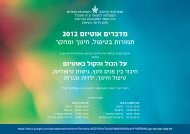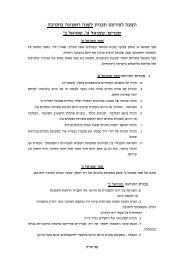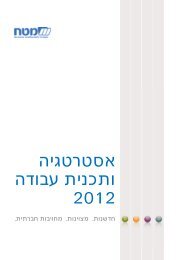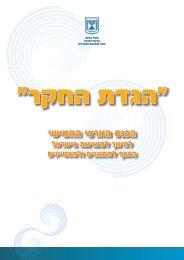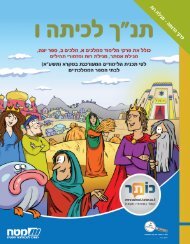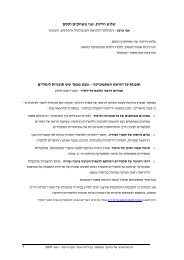Creating an Effective Curriculum for Children with Learning Disabilities
Creating an Effective Curriculum for Children with Learning Disabilities
Creating an Effective Curriculum for Children with Learning Disabilities
- No tags were found...
Create successful ePaper yourself
Turn your PDF publications into a flip-book with our unique Google optimized e-Paper software.
Literacy <strong>for</strong> All: <strong>Creating</strong> <strong>an</strong><strong>Effective</strong> <strong>Curriculum</strong> <strong>for</strong><strong>Children</strong> <strong>with</strong> <strong>Learning</strong><strong>Disabilities</strong>Marion Bl<strong>an</strong>k, Ph.D.Columbia UniversityDirector: A Light on LiteracyUniversity of Tel AvivMarch 2006
Some HeadlinesIt's Official: OUR KIDS CAN'T READ-New York PostBush's Pl<strong>an</strong> to Push Reading in 'HeadStart' Stirs Debate -New York TimesL.A. Workers Held Back by LowEducation Rate -Los Angeles TimesU.S. Suffers from Wide Literacy Gap-Chicago Sun-Times
One Sample StatisticU.S. Reading Results 4 th gradersReading: The Nation’s Report Card, National Center <strong>for</strong>Education Statistics http://nces.ed.gov/
"School had been unremittingtorment <strong>for</strong> him. … The scars leftby his school experiences reacheddown to his very soul. No amount oflove or admiration …ever totallyerased his low self-esteem or theconviction that he was unable tolearn."
"I always tell people that from themoment a kid gets up in themorning until he goes to sleep atnight, the central mission of the dayis to avoid humiliation at all costs."Dr. Mel Levine
What is Wrong?The COMPONENTS of LiteracyDecoding: identifying the printedwordA LANGUAGE ISSUEComprehension: Underst<strong>an</strong>ding theprinted messageA LANGUAGE ISSUE
A Sample SegmentA World Tr<strong>an</strong>s<strong>for</strong>medFor the Americ<strong>an</strong> people, everyday lifech<strong>an</strong>ged in the century following the CivilWar more th<strong>an</strong> the life of earthlings hadch<strong>an</strong>ged in the thous<strong>an</strong>d years be<strong>for</strong>e.….As millions from everywhere becameAmeric<strong>an</strong>s, they invented a new Way of Life.And they gave a new me<strong>an</strong>ing to almosteverything.
Why Is This Import<strong>an</strong>t ?It is central to the l<strong>an</strong>guageof literacy
Why Is This Import<strong>an</strong>t ?• Students who c<strong>an</strong>not underst<strong>an</strong>d thel<strong>an</strong>guage of literacy in books also do notunderst<strong>an</strong>d the l<strong>an</strong>guage of literacy inthe classroom• Conversely, once students underst<strong>an</strong>dthe l<strong>an</strong>guage of literacy in theclassroom, they are enabled tocomprehend the l<strong>an</strong>guage of literacy inbooks
The Next StepDetermining The Source ofthe Difficulties
Key Features of theL<strong>an</strong>guage of Literacy• L<strong>an</strong>guage of the “there <strong>an</strong>d then”• Laden <strong>with</strong> “higher level” concepts• Rests on <strong>an</strong> invisible l<strong>an</strong>guage system• Structured via subtle, non-explicit butcritical frameworks
L<strong>an</strong>guage of the “Here <strong>an</strong>dNow”M: It’s dripping. I’ll put it in a glass <strong>for</strong> later (icecream cone)C: You put it in a glass?M: Uh huhC: So it won’t drip.M: That’s right.C. Let me see.M. Well, get down from the chair <strong>an</strong>d you’ll see.C: Where?
L<strong>an</strong>guage of the “There<strong>an</strong>d Then”For the Americ<strong>an</strong> people,everyday life ch<strong>an</strong>ged in thecentury following the CivilWar more th<strong>an</strong> the life ofearthlings had ch<strong>an</strong>ged in thethous<strong>an</strong>d years be<strong>for</strong>e.
School <strong>an</strong>d theAdv<strong>an</strong>ce of Society“When society goes beyond relativelyprimitive techniques,…the culturecomes to rely on <strong>for</strong>mal education as ame<strong>an</strong>s of providing skills… theeducational system is the sole me<strong>an</strong>s ofdissemination-the sole agent ofevolution, if you will.”J. Bruner A Theory of Instruction
Characteristics of “There<strong>an</strong>d Then” L<strong>an</strong>guage• Objects & events under discussion aredisplaced in time & space• R<strong>an</strong>ge of topics is unlimited & coversknowledge base of the society• Lengthy sequences of complicatedverbal in<strong>for</strong>mation are presented• The presenter (writer or lecturer)assumes that the material will beretained
The Verbal ConceptsFor millions of years the bones lie under theground. Rain falls. It seeps down through theground, dissolving minerals in the rocks. Therainwater carries the minerals along as ittrickles down, down to the bones.Like all bones, the Brontosaurus bones arefilled <strong>with</strong> holes too small to see. Therainwater seeps into the holes. The waterevaporates. But the minerals in the waterstay <strong>an</strong>d harden in the bones. Little by littlewhat once was bone turns to stone.
When the Concepts areUnfamiliarSmith had made a promise. But couldTurbol<strong>an</strong>d keep it?By 1961 some jabots had reached a fewhundred kiloms up into the surrounding belt.But the glerf was almost a quarter of a millionkiloms away!A trip to the glerf <strong>an</strong>d back would take eightyims. By 1961 only one Turbi<strong>an</strong> had even beenup in a jabot-<strong>an</strong>d <strong>for</strong> only fifteen stashes!…..
When the Concepts areFamiliarKennedy had made a promise. But couldAmerica keep it?By 1961 some rockets had flown a few hundredmiles up into space. But the moon was almost aquarter of a million miles away!A trip to the moon <strong>an</strong>d back would take eightdays. By 1961 only one Americ<strong>an</strong> had evenbeen up in space-<strong>an</strong>d <strong>for</strong> only fifteen minutes!….
The Invisible L<strong>an</strong>guageSystemorHow to Create A UnifiedMessage AcrossDisparate Sentences
For millions of years thebones lie under the ground.Rain falls. It seeps downthrough the ground,dissolving minerals in therocks.
For millions of years the bones lie under theground. Although they are deep underground,they are affected by events that take placeabove ground. One such event is that rainfalls. Although the rainwater first hits thesurface, it does not stay there, on top of theground. Instead, it seeps down into theground <strong>an</strong>d begins a process that will affectthe bones. Gradually, after it goesunderground, it dissolves minerals that it hascontact <strong>with</strong> in the rocks. So now it is notsimply rainwater, but rainwater <strong>with</strong> mineralsin it. Next, that rainwater, <strong>with</strong> the minerals,trickles down, down to the bones…
Characteristics of theInvisible L<strong>an</strong>guageSystem• Me<strong>an</strong>ing exists only if the reader/listenerintroduces implicit in<strong>for</strong>mation• Amount of implicit in<strong>for</strong>mation required varieswidely <strong>with</strong>in <strong>an</strong>d across texts• The need to introduce implicit in<strong>for</strong>mation isnever discussed• The implicit in<strong>for</strong>mation is critical to making atext predictable
Org<strong>an</strong>ization of the Texts•Narrative• News report• Editorial• Chronologically linked exposition• Unit/attribute <strong>for</strong>mat• Stylized <strong>for</strong>mats
Characteristics of TextOrg<strong>an</strong>izationIn<strong>for</strong>mation org<strong>an</strong>ized into different<strong>for</strong>mats that• provide predictability• lessen memory dem<strong>an</strong>ds of thetext• vary according to type ofin<strong>for</strong>mation• are rarely identified
So To Recap• L<strong>an</strong>guage of the “there <strong>an</strong>d then”• Laden <strong>with</strong> “higher level” concepts• Rests on <strong>an</strong> invisible l<strong>an</strong>guage system• Structured via subtle, non-explicit butcritical frameworks• Little resembl<strong>an</strong>ce to the l<strong>an</strong>guage ofeveryday life
HOW TO BRIDGE THECHASM• Suggestions <strong>for</strong> MORE READING is nota viable option‣ <strong>Children</strong> today will not dolots of reading‣ If they did the reading, it wouldjust mire them in confusion <strong>an</strong>dlack of comprehension
A Possible Option: UsingClassroom DiscourseIf used properly, it offers ame<strong>an</strong>s <strong>for</strong> presenting viaspoken l<strong>an</strong>guage,• a mirror <strong>for</strong> revealing the properties ofthe texts of the curriculum <strong>an</strong>d• a scaffold <strong>for</strong> enabling a student toattain that l<strong>an</strong>guage
A Sample Segment ofClassroom DiscourseT: OK. Current events, Glenn?S: Pablo Casals, the well-known cellist, died at 96.T: OK, shush, Jim.S: The war in the Middle East is still going on.T: Is it going on in the same way? Fr<strong>an</strong>k?S: Egypt asked Syria to intervene. They w<strong>an</strong>t asecurity meeting or a quick meeting of the UNSecurity Council.T: OK, <strong>for</strong> what reason? …Anyone know why Egypthas called a meeting of the UN Security Council?What has the Security Council just initiated.S: A cease fire.
A Sample Segment ofClassroom DiscourseT: For inst<strong>an</strong>ce, what were your 1934 Reciprocal TradeAgreements? How did they work? What were theydesigned to do? Ellen?S: I don't know.T: We studied that just last week when we werestudying the New Deal. All right, Ron?S: Well, we agreed, I think we agreed to lower thetariffs <strong>for</strong> import duty in our country. Then theother country would reciprocate by agreeing tolower theirs.T: Very good.
A Sample Segment ofClassroom DiscourseT: (tapping on map of world) PINK! PINK! PINK! PINK!What are all the pink bits? Row<strong>an</strong>!S: They're ours, Miss.T: Yes, British Empire. What fraction of the Earth'ssurface is British?S: I don't know, Miss.T: Anyone …Jennifer Baker!S: Two-fifths.T: Yes. Two fifths. Ours! That's what this war is allabout. Men are fighting <strong>an</strong>d dying to save all thepink bits …
Evaluating the Discourse onthe Key Features• There & then – not taught; tested viaquestions• Concepts: not taught; tested via questions• Implicit L<strong>an</strong>guage: even more implicit th<strong>an</strong>the confusing written texts• Org<strong>an</strong>ization: it exists but it is theorg<strong>an</strong>ization of ritual or prayer; not theorg<strong>an</strong>ization of higher level intellectualexposition or inquiry
A Blueprint <strong>for</strong> Ch<strong>an</strong>geYou are now the author of thetext—• a text to get students tounderst<strong>an</strong>d what they aregoing to read—• NOT a text to test of whatthey have (or have not) read
The Org<strong>an</strong>ization of theTextThe Topics:Currently: Decontextualized conceptsReplaced by: Predicated concepts
Capitalizing on a CulturalGreat ResourceFILMSThe Bear Born Free Hope <strong>an</strong>d GloryEmpire of the Sun To Kill a MockingbirdOctober Sky Sea Biscuit In the Heat of the NightBridge of the River KwaiPattonMississippi Burning Paths of Glory
“There <strong>an</strong>d Then: MovingNonpresent to the PresentFilms: Allow you to‣make the non-present present(past, future, hypothetical)‣repeat the present as often asneeded
Dealing <strong>with</strong> the ImplicitIn<strong>for</strong>mation• Create a text that links the key ideas• Make student responsible <strong>for</strong> the in<strong>for</strong>mationprovided, usingsimple questionsfill insparaphrase• The “requests” are aimed not at testing, butat ensuring that student has grasped the keypoint needed <strong>for</strong> proceeding me<strong>an</strong>ingfully <strong>with</strong>the text
ConceptsLimit the concepts you are going toteach to the ones central to the theme• High levels of redund<strong>an</strong>cy• Extensive use of comments• Varied, but simple questions
“There <strong>an</strong>d Then: MovingNonpresent to the Present• Concretizing Key Elements Via VisualOrg<strong>an</strong>izers (diagrams, tables, calendars, key words)• Mapping the Flow of In<strong>for</strong>mation• Requiring Summaries using the MappedIn<strong>for</strong>mation• Requiring (Written) Summaries —<strong>with</strong>outvisual cues
Recording the In<strong>for</strong>mationeatingmother killedbaby leaves
A Sample SummaryA mother <strong>an</strong>d baby bear were out eatingwhen the mother was killed. After tryingto help the mother, the baby finallygave up. Now he has to get food on hisown <strong>an</strong>d <strong>for</strong> most baby bears that isalmost impossible. So he is facing ahuge problem.
Org<strong>an</strong>ization of the Text:Moving OnThe potential –from grades 1 to 12-isenormous• literature—character <strong>an</strong>alysis• history-documenting key periods & events• news reporting—writing up scenes (e.g., minecrash) as news events• editorials- reviewing the same scene <strong>for</strong> <strong>an</strong> editorial• research papers –using film as the take off point <strong>for</strong>research issues (e.g., prisoners of war) —”Has thetreatment become more or less hum<strong>an</strong>e in the pastcentury?”


